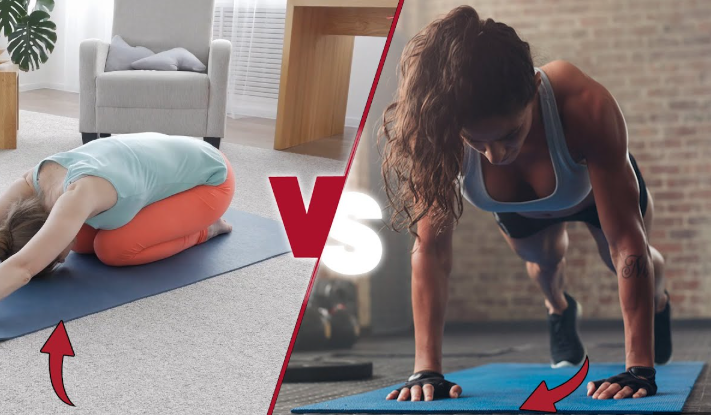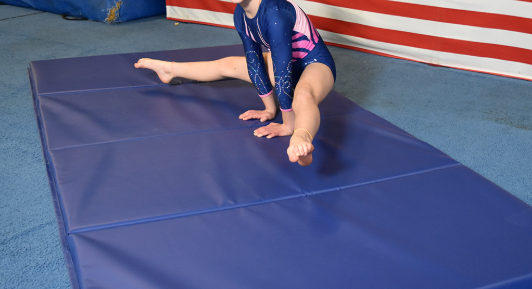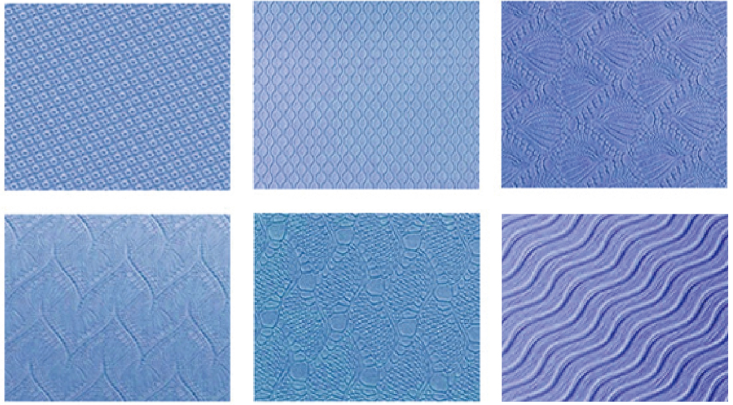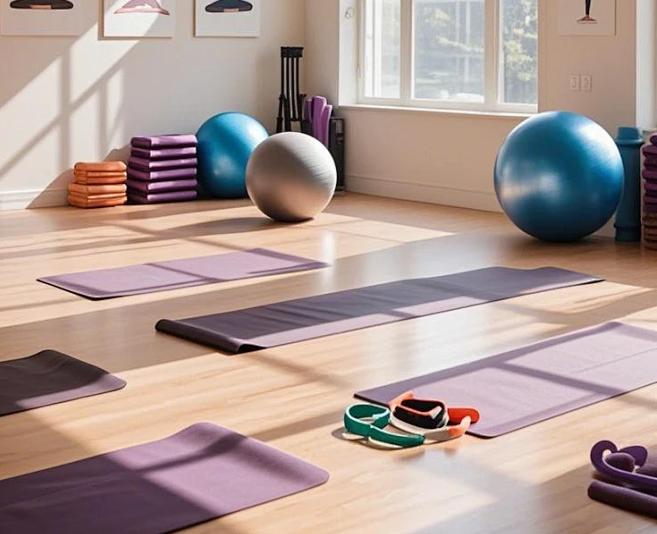I find that picking the right workout mat can be tricky. Gym mats and yoga mats look alike. But I think they have different uses and special qualities. Knowing these differences helps you choose wisely. I suggest you think about what you need for your fitness goals.
Differences at a Glance
Here’s what I’ve learned about their key differences:
– Purpose: Gym mats are, in my experience, for high-impact workouts. Yoga mats are for stability and grip.
– Thickness: I’ve found gym mats are thicker. Yoga mats are thinner.
– Material: I notice gym mats might use durable foam. Yoga mats often use rubber or PVC.

Purpose and Use Case
I believe picking the right workout mat is really important. It can make your training much better. Let me show you what gym mats and yoga mats are for and how I see their uses.
Gym Mats
Gym mats are built for high-impact workouts. I find they offer great cushioning. This padding is super helpful because it protects your joints during intense activities. This makes them good for things like:
– Aerobics: I recommend them for aerobics because they soak up the shock when you move hard.
– Weightlifting: They protect your floor. They also keep you stable when you lift heavy weights, which I think is crucial for safety.
– Floor Exercises: They give you comfort for any exercises you do on the ground.
Prices for gym mats usually range from $30 to $150. From my experience, this price depends on how thick they are and the material quality. Thicker mats or those with more durable foam might be on the higher end.
Yoga Mats
Yoga mats, on the other hand, I feel are made for the stability and grip you need in different yoga styles. Good grip is essential so you don’t slip during poses, which is a big plus in my book. They are really good for:
– Static Movements: They help you keep your balance during poses.
– Controlled Stretches: I like that they give you a non-slip surface for deep stretches and holding poses. This lets you focus on the stretch itself.
– Balance-Focused Practices: For practices where you need balance, I find they help with moving between poses and keeping good posture. This stability allows for smoother transitions.
Yoga mats usually cost between $20 and $100. The price can change based on the brand’s name, the quality of materials, and the production method. I’ve noticed that some well-known brands charge more, but if you work with the right yoga mat supplier, you can often find great quality at a lower price—especially when buying in bulk or customizing for your brand.
Material Differences
I think it’s important to know how gym mats and yoga mats are different. This helps you pick the best one for your workouts.
Gym Mats

Gym mats are often made from strong materials like EVA foam or rubber. From my experience, these materials are great because they are thick and absorb shock very well. This means you get the padding you need for high-impact exercises.
Yoga Mats

Yoga mats use materials like TPE, natural rubber, PVC, or even cork. I believe these materials are chosen because they offer a non-slip surface. They provide good comfort and grip. These features are key for holding different yoga poses. Many of these materials are also eco-friendly, which I appreciate.
Material Highlights
Here’s what I think is important to remember about the materials:
– Gym Mats: These are usually made from EVA foam or rubber. I find they are very durable and thick, which helps absorb shock.
– Yoga Mats: These use TPE, natural rubber, PVC, or cork. From my perspective, their main benefits are good grip, comfort, and many are eco-friendly options.
Thickness and Cushioning
I think picking the right thickness and cushion is really important when you’re choosing between gym mats and yoga mats. From my experience, each mat type works for different things. This changes how comfortable you feel and how well you perform during your exercises.
Gym Mats
Thickness: Gym mats are thicker. They range from 10mm to 50mm+.
Cushioning: They offer a lot of cushioning. This is perfect for absorbing impact during your intense workouts. Based on my experience, this cushioning really helps protect your joints. I recommend it for activities like aerobics, weightlifting, or any floor exercises.
Yoga Mats
Thickness: I’ve noticed yoga mats are thinner. They are often 3mm to 6mm. You can find some up to 8mm if you want extra cushioning for floor-based poses.
Cushioning: I suggest these because they offer moderate cushioning. This helps you feel stable and get a good grip. In my opinion, this is crucial for keeping your balance in different yoga poses. It also lets you go into deeper stretches. You won’t lose your connection to the floor.
Texture and Grip
If you’re picking between gym mats and yoga mats, I think texture and grip are really important. They affect how well the mat works and how safe you are.
Yoga Mats
From my experience, yoga mats often have surfaces with texture or a sticky feel. This design helps stop you from slipping during poses. A good grip is key for balance, particularly with different yoga styles. Many yoga mats use materials like rubber or PVC. I find these materials make them less slippery. I think this grip helps you focus on your posture. You don’t have to worry about losing your balance.
Gym Mats
Gym mats, I’ve noticed, can have a smoother surface or one with interlocking parts. Their main job is to support high-impact activities. They also stop equipment from shifting around while you work out. The cushioning in gym mats absorbs shock. This lessens the impact on your joints. I recommend this design for high-energy exercises like aerobics and weightlifting. Stability and cushioning are really important for those activities.
So, to put it simply, the textured surfaces of yoga mats improve grip and stability for your yoga. On the flip side, gym mats offer a cushioned and stable base that’s good for high-impact workouts.
Size and Portability
For gym mats and yoga mats, I think size and portability are important. These factors can really shape your fitness routine.

Size
Yoga Mats: Standard yoga mats are usually 68″–72″ long and 24″ wide. From my experience, these sizes give you enough space for many poses and movements during practice.
Gym Mats: Gym mats are often larger and their sizes can differ a lot. You might find them as large rolls or interlocking tiles. I’ve seen these mats cover big workout spaces. This makes them good for group exercises.
Portability
Yoga Mats: I really like how lightweight yoga mats are. This makes them easy to take with you. You can roll them up and carry them easily. This is great if you practice at home or go to a studio. I find this super convenient.
Gym Mats: Gym mats, on the other hand, are bulkier and heavier. This makes them harder to move. I’ve found they are not so easy to carry if you want to work out outside or in new places.
So, to sum it up, I find yoga mats are best for your personal practice. Gym mats, I believe, are great for wider uses and can cover big workout areas.
Cost and Durability
I think when you pick a gym mat or a yoga mat, it’s good to know about their cost and how long they last. I find they both do different jobs. Their prices also change depending on what they’re made of and how you plan to use them.
Gym Mats
From my experience, gym mats cost between $30 and $150. I’ve noticed the price changes with thickness and material quality. Thicker mats often cost more. I see these mats are made for tough workouts. This makes them last longer. In my experience, gym mats made from high-quality materials like EVA foam or rubber hold up well. They absorb shock and resist wear.
Yoga Mats
I’ve seen yoga mats priced between $20 and $100. Brand and material quality affect the price—well-known brands might be pricier. But if you work with a reliable yoga mat supplier, you can often find great mats for less without sacrificing quality. I find that yoga mats are usually thinner, focusing more on grip and stability than extra cushioning. Because of this, they might not last as long as gym mats if used for intense workouts. However, many yoga mats now use eco-friendly materials like natural rubber and TPE. If you take good care of them, these materials can help the mat last longer while reducing environmental impact.
Longevity Based on Usage
Gym Mats: I recommend gym mats for activities with a lot of impact. If you care for and clean them well, I think they will last longer.
Yoga Mats: I suggest yoga mats are better for lighter use. To keep them from wearing out, I believe regular upkeep is important.
I think if you understand the costs and how durable each mat is, you can make a smart choice. This helps you pick one that really works for your fitness goals.
Which One Should You Choose?
I find that picking a gym mat or a yoga mat comes down to your workout style and what you need. Mats have different uses. If you understand these differences, I believe you can pick the best one for you.
Workout Type
High-Impact Activities: If you do high-impact workouts like aerobics or weightlifting, I recommend gym mats. These mats have thicker cushioning (10mm to 50mm+). This extra thickness absorbs shock well and helps protect your joints.
Yoga and Balance: For yoga or Pilates, where stability and grip are key, I suggest yoga mats. These are usually thinner (3mm to 8mm). This thickness gives you good grip for poses and stretches.
Space and Portability
Gym Mats: From my experience, gym mats are often larger and bulkier. They come in many sizes, like rolls or interlocking tiles. I find this makes them good for bigger workout spaces, but they are harder to move around.
Yoga Mats: Yoga mats are light and easy to roll up. I think they are great for travel. They are a standard size (68″–72″ long and 24″ wide). This size gives you enough room for most yoga poses. You can easily take them to a studio or outside.
Personal Preference
Comfort and Cushioning: If you want more cushioning for comfort during tough workouts, I’d say go for gym mats. On the other hand, if you need stability and flexibility for yoga poses, yoga mats are what I recommend.
Material Considerations: Gym mats usually use strong materials such as EVA foam or rubber. These materials make them durable and help absorb shock. Yoga mats often use materials that are better for the environment, like TPE, natural rubber, or PVC. These focus on grip and comfort.
So, what’s my final advice? I think your choice should come down to a few things. Think about your workout routine. Consider how much space you have and if you need to carry your mat around. Your personal comfort is also very important. I suggest you think carefully about these points. This will help you choose the mat that truly fits your fitness goals.
Expert Opinion:
“From my 15 years as a fitness coach, I always tell my clients: picking the right mat is a key part of their workouts. When clients ask about gym mats compared to yoga mats, I explain it’s more than just their personal liking. I believe it’s really about preventing injuries and boosting their performance. I’ve found that using the wrong mat can cause slips or strain joints. It might also mean you don’t get enough support during key exercises. I have seen many people make their workouts less effective. This happens when they use a yoga mat for intense training or a gym mat for poses needing balance. Based on my experience, knowing your main workout style and getting the right mat for it will make you safer. It will also help you get better results.”
———— Sarah Mitchell , Certified Personal Trainer and Fitness Studio Owner with specialization in equipment guidance and injury prevention
Summary
Choosing between a gym mat and a yoga mat depends on your workout needs. Yoga mats are perfect for stability, flow, and comfort during practices like yoga, Pilates, or stretching. Gym mats, on the other hand, offer more thickness and protection for high-impact exercises and floor training. Whether you’re setting up a home gym or sourcing products for your fitness brand, understanding the key differences helps you make smarter choices. And if you’re working with a trusted yoga mat supplier, you can even find customized mats that fit your exact style, function, and budget.

